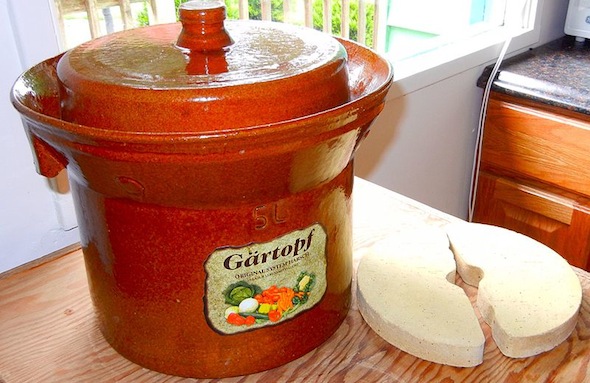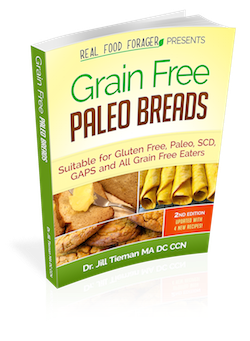I’ve received a lot of emails this past week from readers asking questions about fermentation that are really beyond my scope. I consulted with the expert, Jenny McGruther of Nourished Kitchen and creator of the excellent fermentation class, Get Cultured. I knew she would be able to answer all of these questions!
From Helene — I have been dairy free for several months and do not want to use whey. Is there any reason not to use water kefir or coconut water kefir as a starter to culture condiments like mayonnaise, fruits or vegetables?
There are many alternatives to whey for those who are dairy free. First, most ferments don’t require any starter culture such as fermented vegetables like sauerkraut, sour beets, sour turnips etc. Of those few ferments that actually do need a starter culture like chutneys, fruit butters and various probiotic tonics, I recommend using either a packaged commercial starter culture such as one from Caldwell’s or Body Ecology, a probiotic capsule that has been emptied into what your fermenting or the brine of previously fermented vegetables. I don’t recommend using water kefir, coconut kefir or kombucha as a starter because it may cause ferments to become unpleasantly yeasty and, sometimes, slimy.
From Sherry — What is the maximum temperature at which you can store the finished jars of ferments?
There is no maximum temperature for ferments. They can continue to sit at room temperature, but remember they will continue to ferment as they sit. If you wish to halt fermentation, store them at about 40 degrees or so.
From Shar — Are there places other than the refrigerator to store the finished ferments and how low can the temperature go? And is freezing ferments OK?
You can store your ferments in a root cellar, in a basement, in a garage – or in any other place that is kept cool. Freezing will damage the probiotics to some degrees. The faster and colder you can freeze your foods, the better – but in general you want to avoid freezing them as freezing will break down the cellular structure of the bacteria to some degree.
From Arlene — In making coconut milk yogurt, will using honey along with the starter culture work or should you use sugar just as a source of food for the bacteria? Also, is the coconut milk yogurt always so watery? Mine doesn’t seem to thicken or “culture”.
You don’t need sugar for coconut milk yogurt. There’s enough carbohydrate in coconut milk to support fermentation. Your yogurt doesn’t thicken because you’re not using a true milk. Your coconut milk is almost certainly culturing. The thick coconut milk yogurts you find in the grocery store are usually thickened with additives. If you want a thick coconut milk yogurt, you either have to add a gelatin or agar agar after culturing the coconut milk, or you need to culture young coconut meat and puree it.
From Claudia — How do I know when the water kefir has all the sugar out — and will it still taste good? I am on GAPS and do not want to have any sugar.
Unless you have a way of testing your water kefir (which is unlikely), you won’t know for certain, but if it tastes sweet, some sugar will still remain. The time it takes for the bacteria to consume all the sugar varies considerably based on ambient room temperature. Try it after three days, and if it still tastes sweet let it continue fermenting.
From Jane — Sometimes my beet kvass and my water kefir has a white film and white “stuff” on the surface. I usually just spoon that off and use the rest. Is this safe? What is this and is there a way of preventing this?
A white film is very unusual for water kefir which typically has a short period of fermentation – not long enough for molds to develop. For beet kvass, it’s pretty normal to see it develop some sort of film – much like sauerkraut does. Spooning it off is fine. If you don’t want to see one develop, using an airlocked device like a specially designed fermentation crock or a glass jar equipped with a weight and airlock will help to eliminate the chance of it forming; however, these can be expensive and aren’t necessary unless the film really does bother you.
From Karen — Why do some people recommend a tight lid on ferments and others a kitchen cloth or cheesecloth rubberbanded around the top? Which is correct?
There is no correct answer. The correct way to ferment is to figure out what works for you. Some people use a tight lid to prevent airflow. The problem of this method is that it also doesn’t allow for gas created by fermentation to escape, so you end up with fizzy ferments at best (and exploding jars at worst) – unless you burp the jars regularly. Other people do cheesecloth to allow the gas created by fermentation to escape. As long as what you’re fermenting rests below the level of the brine, your ferment will be fine – tight lid, cloth, loose lid or whatever.
Well, I don’t know about you but, I just learned a heck of a lot from just a few of my readers’ questions. I wish Jenny were around all the time to answer ALL my questions about fermentation! Wait! There is a way to engage Jenny and her expertise on this subject! I asked Jenny what kind of support is offered with the class and here is her answer:
Participants can email me through the NourishedKitchen.com – and those taking the classes or subscribing to the meal plans get premium support which means I answer their questions as soon as I can (usually 1 to 2 business days max, and often within a few hours) while I can only answer general reader questions every once in a while. They also have access to periodic conference calls where they can email questions in advance, and I answer them in the call and then we open up to full discussion. And, lastly, if someone is really struggling we set up a private one-on-one call, and those usually take about 15 minutes.
The best way to reinoculate ourselves with beneficial bacteria is to eat cultured foods. Learn how to culture anything! From the most common yogurt to more esoteric culturing of vegetables, salsa, chutneys and condiments — most foods can be fermented — their shelf live lengthened without chemical preservatives, and most importantly, the beneficial bacteria is created.
By eating cultured foods on a daily basis you are building up the colonies of good bacteria that do so much for us and you are protecting yourself from the pathogens created by our dangerous food supply.
Register for Get Cultured! How to Culture Anything
Jenny from Nourished Kitchen is offering a $50.00 off coupon code, in addition to the sale, that is good through the end of May.
- Original price:
$197.00 - Sale price:
$147.00 - Price with coupon: $97.00 — less than $7.50 per class!
Use code WEBINAR at check out for the $50.00 discount.
Act now! — If you order today you will also receive the e-book Get Cultured! Probiotic Recipes from Nourished Kitchen.
Click here to find out more about the class and to register
If you do not have the time or desire to learn this art, we have a great supplier of fermented vegetables and juices here.
This post is shared at: Whole Foods Wednesday, Allergy Free Wednesday, Whole Food Wednesday, Mommy Club, Real Food Wednesday, Sustainable Ways, Healthy 2Day, Fresh Bites Friday, Freaky Friday, Country Homemaker Hop, Fight Back Friday,LHITS Linky, Sunday Celebration, Sunday School, Monday mania, Meatless Monday, Mouthwatering Monday, Hearth & Soul Hop, Tasty Tuesday 33, Allergy Free Wednesday, Sustainable Ways, Whole Food Wednesday, Whole Foods Wednesday, Healthy 2Day, Real Food Wednesday, Creative Juice Thursday, Simple Lives Thursday
Photo Credit
















